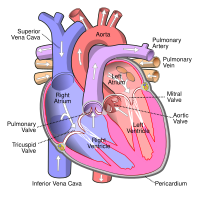
Photo from wikipedia
Aortic valve repair is the preferred approach for the treatment of severe aortic insufficiency (AI), as it allows patients to keep their native aortic valve, thus substantially reducing the risk… Click to show full abstract
Aortic valve repair is the preferred approach for the treatment of severe aortic insufficiency (AI), as it allows patients to keep their native aortic valve, thus substantially reducing the risk of prosthesis-related complications. Several studies have documented excellent long-term outcomes of aortic valve repair. The major complication of this operation is AI recurrence, with ensuingneed for reoperation. The surgical experience accumulated over the last two decades has allowed for better understanding of the mechanisms of recurrent AI after aortic valve repair. Herein, we review the current state of knowledge on predictors of aortic valve repair failure. These include unaddressed annular dilation, residual cusp prolapse or retraction, commissural orientation, and use of patch material. This enhanced understanding has led to the development of increasingly refined techniques and improved patient outcomes. Continued follow-up and detailed data collection at the time of surgery, together with three-dimensional echo imaging, will allow further improvements in aortic valve repair.
Journal Title: Innovations: Technology and Techniques in Cardiothoracic and Vascular Surgery
Year Published: 2019
Link to full text (if available)
Share on Social Media: Sign Up to like & get
recommendations!